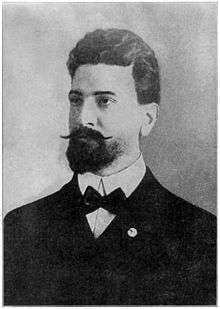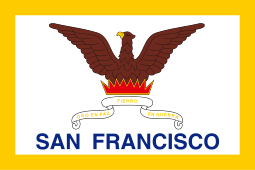Eugene Schmitz
Eugene Edward Schmitz (August 22, 1864 – November 20, 1928), often referenced as "Handsome Gene" Schmitz, was an American musician and politician, the 26th mayor of San Francisco (1902-7), who was in office during the 1906 San Francisco earthquake.
Eugene Schmitz | |
|---|---|
 | |
| 26th Mayor of San Francisco | |
| In office January 8, 1902 – July 8, 1907 | |
| Preceded by | James D. Phelan |
| Succeeded by | Charles Boxton |
| Personal details | |
| Born | August 22, 1864 San Francisco, California, U.S. |
| Died | November 20, 1928 (aged 64) San Francisco, California, U.S. |
| Political party | Union Labor Party |
| Profession | Musician, Politician |
Life and career
Born in San Francisco, Schmitz was the son of an Irish mother and a German father. He played the violin and conducted the orchestra at the Columbia Theatre on Powell Street in San Francisco and was president of the Musicians' Union, when city boss Abe Ruef chose him to run for mayor of his hometown on the ticket of the Union Labor Party. Schmitz was elected in 1902, thereafter giving protection to criminals, including houses of prostitution for protection money, while remaining popular with the working class. Despite opposition from a reform candidate backed by a fusion party, he was reelected in 1905.[1] He was still mayor when the 1906 San Francisco earthquake and subsequent fire destroyed a prodigious amount of the city. On the day of the earthquake, Wednesday, April 18, 1906, he invited a cross-section of the city's most prominent businessmen, politicians and civic leaders, but none of the members of the Board of Supervisors, to form the Committee of Fifty to help him manage the crisis.
On June 13, 1907, Schmitz was found guilty of extortion, and the office of mayor was declared vacant while he was sent to jail to await sentence. Shortly thereafter, he was sentenced to five years at San Quentin State Prison, the maximum sentence the law allowed. He immediately appealed; while awaiting the outcome, he was kept in a cell in San Francisco County Jail.
On January 9, 1908, the District Court of Appeals nullified his conviction. Two months later, the California Supreme Court upheld the Court of Appeals' ruling, and he was released on bail pending the resolution of the outstanding bribery indictments. In 1912, he was brought to trial once more, this time on charges of bribery; however, after Abe Ruef was brought from San Quentin to testify and refused to give evidence, and the other key witness, Chief Supervisor Gallagher, fled to Canada, Schmitz was acquitted.
Schmitz ran for mayor again in 1915 and 1919, but was soundly defeated due to his past reputation. Elected to the Board of Supervisors in 1921, he remained until 1925. He was married and had two daughters.
Literature
- New International Yearbook for 1907 and 1908
- George Kennan, "The Fight for Reform in San Francisco," McClure's, Sept. 1907 & Nov. 1907.[1]
Notes
- Kennan, George. "Publication". The Unz Review.
References
- Walton Bean: Boss Ruef's San Francisco: The Story of the Union Labor Party, Big Business, and the Graft Prosecution (University of California Press, Berkeley, 1952; republished Greenwood Press, 1981, ISBN 0-313-23211-3).
- Gordon Thomas & Max Morgan Witts: The San Francisco Earthquake (Stein and Day, New York; Souvenir Press, London, 1971; reprinted Dell, 1972, SBN 440-07631).
External links
![]()
- Schmitz' "Shoot to kill" order at the Virtual Museum of the City of San Francisco
- 1907 editorial cartoon from the San Francisco Examiner
- Photographs related to the San Francisco graft trial, 1907–1908, The Bancroft Library
- . Encyclopedia Americana. 1920.
| Preceded by James D. Phelan |
Mayor of San Francisco 1902–1907 |
Succeeded by Charles Boxton |
